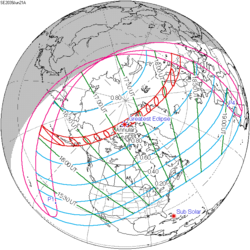| Annular eclipse | |
| Gamma | 0.1389 |
|---|---|
| Magnitude | 0.9655 |
| Maximum eclipse | |
| Duration | 240 s (4 min 0 s) |
| Coordinates | 31°24′N67°12′W / 31.4°N 67.2°W |
| Max. width of band | 126 km (78 mi) |
| Times (UTC) | |
| Greatest eclipse | 16:29:51 |
| References | |
| Saros | 135 (33 of 71) |
| Catalog # (SE5000) | 9300 |
An annular solar eclipse occurred at the Moon's ascending node of orbit on Sunday, June 28, 1908, [1] [2] [3] [4] with a magnitude of 0.9655. A solar eclipse occurs when the Moon passes between Earth and the Sun, thereby totally or partly obscuring the image of the Sun for a viewer on Earth. An annular solar eclipse occurs when the Moon's apparent diameter is smaller than the Sun's, blocking most of the Sun's light and causing the Sun to look like an annulus (ring). An annular eclipse appears as a partial eclipse over a region of the Earth thousands of kilometres wide. Occurring about 4 days before apogee (on July 2, 1908, at 16:30 UTC), the Moon's apparent diameter was smaller. [5]
Contents
- Eclipse details
- Eclipse season
- Related eclipses
- Eclipses in 1908
- Metonic
- Tzolkinex
- Half-Saros
- Tritos
- Solar Saros 135
- Inex
- Triad
- Solar eclipses of 1906–1909
- Saros 135
- Metonic series
- Tritos series
- Inex series
- Notes
- References
The annular eclipse was visible in North America, including a part of central Mexico around Mexico City; Orlando; and Daytona Beach, Florida in the United States. In Africa, it included Rosso, Mauritania, the northernmost part of Senegal, Bamako and the southwestern French Sudan (now Mali), the southwesternmost part of Upper Volta (now Burkina Faso) and northern British Gold Coast (now Ghana). A partial eclipse was visible for parts of northern South America, most of North America, the Caribbean, West Africa, North Africa, and Western Europe.








































































































